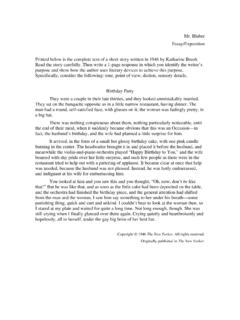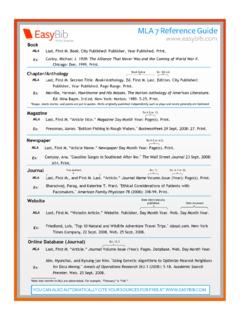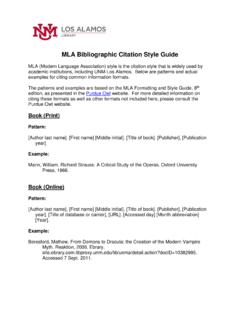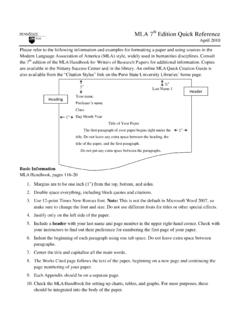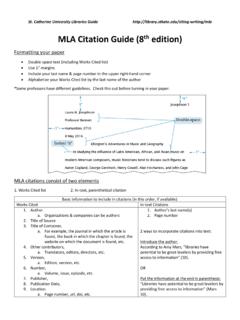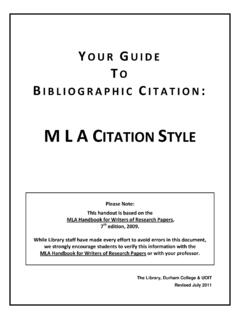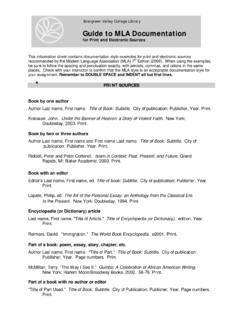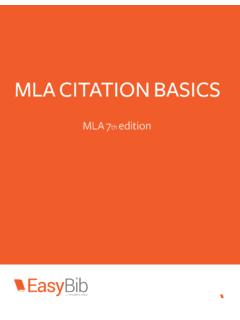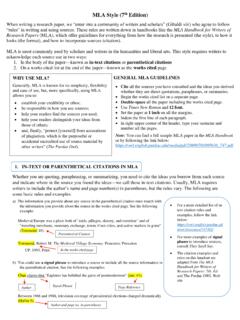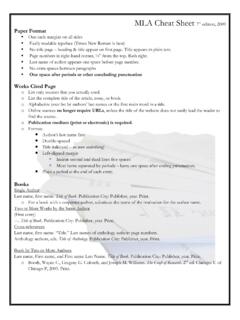Transcription of MLA 7 –Understanding Citations - rhsweb.org
1 MLA 7 understanding Citations Generally, Citations follow the below format. Contributor. Title. Secondary Contributors. Publication Information. Medium. Contributor Information and Titles The main contributors to the source, normally the author, are placed before the title. If there is more than one author, then arrange the authors in the same order found in the source. Reverse only the name of the first author, and follow the rest in normal form. One author Smith, John K. Title Two authors Smith, John K,. and Tim Sampson. Title. Three authors Smith, John K., Tim Sampson, and Alex J. Hubbard. Title. More than three authors Smith, John K., et al. Title. Sometimes the main contributor is not an author, but another contributor type, such as an editor for a book or conductor for a musical piece. In this instance, follow the contributor by an abbreviation of the contributor type ( ed.)
2 Or cond.). If plural, then change the abbreviation accordingly. One editor Smith, John K., ed. Title Two editors Smith, John K,. and Tim Sampson, eds. Title. One conductor Smith, John K., cond. Title. Many sources have secondary contributors - individuals who added to the work outside the main contributors. This can include editors and translators for books, and producers and screenplay writers for movies. Place secondary contributors after the title. Precede the name of the contributors with the abbreviation for the contributor type. For instance, Ed. means Edited by.. One editor Smith, John. Title. Ed. Bill McCoy. Two editors Smith, John. Title. Ed. Bill McCoy and Tim Thomas. One conductor and Smith, John. Title. Cond. Bill McCoy. Prod. Tim Thomas, Jane Horton, three producers and Rex Bryant. You may decide to emphasize the work, for example, when citing a live performance.
3 In this instance, place all the contributors after the title. Authors and writers are preceded by the word By.. One author and editor Title. By John Smith. Ed. Bill McCoy. Some sources may have corporate or group authors. Write these organization where you would write the authors. If they are also publishers of the source, include it in the publication information as well. Corporate author Modern Language Association. Title Government author Illinois. Dept. of Industrial Title. YOU CAN ALSO AUTOMATICALLY CITE YOUR SOURCES FOR FREE AT MLA 7 understanding Citations Some sources are found within other sources, such as a chapter in a book, or an article in a periodical. These rules apply both to the contributors of the chapter and book, or to the article. Chapter author and Smith, John. Chapter. Ed. Bill McCoy. Title. Comp. Russell Engels and editor and two book Steve Simpson.
4 Compilers Author and translator of Smith, John. Chapter. Trans. Bill McCoy. Periodical Title an article Title Rules Generally, capitalize all principal words as well as the first word and last word in the title. If citing a title for an entire source, such as a book or periodical title, place in italics. If citing an article, essay, poem or short story within a lager work, place in quotes. If a novel or published independently, then place in italics. Publication Information After the title and contributor information comes the publication information. In MLA7, you must also list the publication medium (Print, Web) after the publication information. Below are different publication information templates. Book Last, First. Title. City of Publication: Publisher, Year Published. Medium. Journal Last, First. Title (Year): Page Numbers.
5 Medium. Magazine Last, First. Title Day Month Year Published: Page Numbers. Medium. Newspaper Last, First. Title [City] Day Month Year, Edition, Section: Page Numbers. Medium. If you cannot find all publication information, use place holders , , which represents no place, no publisher, and no date. If there are no page numbers use N. pag. Capitalize the abbreviations appropriately based on where they are placed. Note that we format according to MLA7, we believe adding such place holders is unnecessary, as it provides no information, and the lack of information can be assumed by its absence in the citation . Additional information For less conventional source types, you can add descriptions about the source after the title. For example, you can add Cartoon. or Map. after the title of a cartoon or map to clarify to the reader what type of source you are citing.
6 When citing non-periodical sources, advanced information such as the edition and section come before the publication information. Series information comes after the medium description. See the fictional example below: Smith, John. Power. Ed. Tom Riley. 5th ed. Vol 12. New York: Random, 2002. Print. Ser. 50. Web Sources See our web resources guides to learn how to properly cite sources found online. YOU CAN ALSO AUTOMATICALLY CITE YOUR SOURCES FOR FREE AT MLA 7 Citing Online Sources When citing sources from the internet, try adding as much of the following in the same sequence: 1. Contributor information 5. Publisher or sponsor of website 2. Title of work (quotes) 6. Date of electronic publication 3. Title of overall website (italicized) 7. Medium of publication (web). 4. Version / Edition 8. Date accessed 1 2 3 4 5 6 7 8. Contributors.
7 Title. Website. Edition. Website Publisher, Date. Web. Date accessed. *Note that MlA7 does not require a URL. However, we encourage you to include it. Do so in angled brackets at the end of the citation Sources Published Directly Online Sources published directly online have no in print originals, and therefore, it is important to include online publication information ( the website publisher/sponsor and date of electronic publication). If unavailable, for online only sources, MLA7 suggests writing , which means no publisher and no date, respectively. We believe adding such place holders is unnecessary, as it provides no information, and the lack of information can be assumed by its absence in the citation . Citing an article from an online only resource Friedland, Lois. "Top 10 Natural and Wildlife Adventure Travel Trips." New York Times Company, 22 Sept.
8 2008. Web. 25 Sept. 2008. Citing an entire website with no identifiable electronic publication date ImagineEasy Solutions, Web. 8 May 2009. Note that newspaper and magazines websites, that may even have in print copies, are considered non- periodical, directly published online sources. Follow the published directly online format. Citing an article from an online only news source Chen, Stephanie. Growing up is Hard with Mom in Prison Cable News Network, 7. May. 2009. Web. 8 May 2009. Many times, the publisher's name is the same as the online newspaper name. Citing an article from an online newspaper Shorto, Russell. Going Dutch. New York Times. New York Times, 3 May. 2009. Web. 8 May 2009. Some online only sources have publication information unique to its source type, such as online only journals (volume & issue information). Follow the journal format and add information on the date accessed.
9 Glotzer, Richard and Anne Federlein. Miles that Bind: Commuter Marriage and Family Strength. Michigan Family Review 12 (2007): 7-31. Web. 8 Apr. 2009. YOU CAN ALSO AUTOMATICALLY CITE YOUR SOURCES FOR FREE AT MLA 7 Citing Online Sources Sources Published Indirectly Online As opposed to some sources published by a website (direct), other sources may be originally in print, or in another medium, and found online. Cite these sources as you would in their original form, and then add as much relevant web information as possible (website title, publisher / sponsor, date of electronic publication, medium, and date accessed). However, because the source was not published by the website, you do not have to use the , place holders if no website publisher or date of electronic publication is available. Citing a book originally in print found online Catton, Bruce.
10 The Civil War. Boston: Houghton Mifflin Co., 2005. Google Book Search. Web. 15 May 2008. Citing a newsletter found online with no page information Puzzanchera, Charles. "Juvenile Arrests 2007." Juvenile Justice Bulletin (Apr. 2009): n. pag. National Criminal Justice Reference Service. Web. 8 May 2009. Citing a video found online West, Kanye. Amazing. Prod. Hype Williams. Roc-A-Fella Records, 2009. Youtube. Web. 8 Feb. 2009. Citing a painting viewed online Picasso, Pablo. Three Musicians. 1921. Web. 5 Apr. 2006. Citing a musical recording listened to online, with no discernable manufacturer or date Park, Obadiah. Hey Ya. Web. 10 Feb. 2007. Sources found in online databases typically have been published elsewhere. Include as much as the original publication information as possible, and then add the database name, medium (web), and the date accessed.
